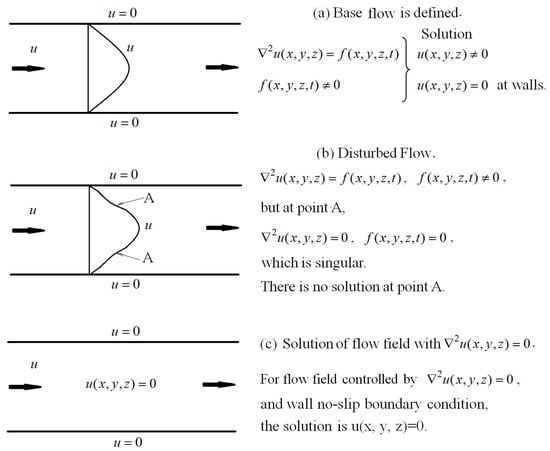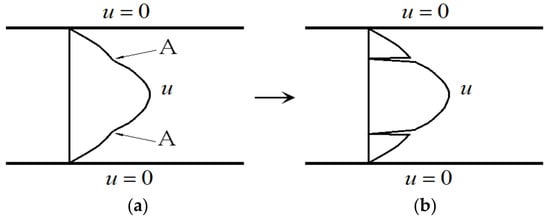Abstract
The Navier-Stokes equation can be written in a form of Poisson equation. For laminar flow in a channel (plane Poiseuille flow), the Navier-Stokes equation has a non-zero source term (∇2u(x, y, z) = Fx (x, y, z, t) and a non-zero solution within the domain. For transitional flow, the velocity profile is distorted, and an inflection point or kink appears on the velocity profile, at a sufficiently high Reynolds number and large disturbance. In the vicinity of the inflection point or kink on the distorted velocity profile, we can always find a point where ∇2u(x, y, z) = 0. At this point, the Poisson equation is singular, due to the zero source term, and has no solution at this point due to singularity. It is concluded that there exists no smooth orphysically reasonable solutions of the Navier-Stokes equation for transitional flow and turbulence in the global domain due to singularity.
1. Introduction
In the past 50 years, researchers have conducted theoretical, experimental and direct numerical simulation (DNS) works on the Navier-Stokes equation and have shown that the flow field governed by this equation coincides well with the data on both the laminar flow and the turbulent flow. Therefore, people believe that the Navier-Stokes equation describes both the laminar flow and turbulence qualitatively and quantitatively. However, whether the three-dimensional (3D) incompressible Navier-Stokes equation has unique smooth (continuously differentiable) solutions is still not known [,].
Leray showed that the Navier-Stokes equations in three space dimensions always have a weak solution for velocity and pressure, with suitable growth properties [], but the uniqueness of weak solutions of the Navier-Stokes equation is not demonstrated. Further, the existence of a strong solution (continuously differentiable) of the Navier-Stokes equations is still a challenge in the community of mathematics and physics, although much effort has been made around the world.
Dou and co-authors studied the origin of turbulence using the energy gradient theory [,,,,,] and discovered that there is velocity discontinuity in transitional flow and turbulence [], which is a singularity of the Navier-Stokes equation. The singularity found theoretically is in agreement with the burst phenomenon in experiments. It was concluded that there exist no smooth and physically reasonable solutions of the Navier-Stokes equation at a high Reynolds number (beyond laminar flow) [].
As is well known, the flow of viscous incompressible fluid is governed by the Navier-Stokes equation, which is a Poisson equation. The steady laminar flow is dominated by the Poisson equation with the source term of no vanishing. As observed in experiments and simulations, when the incoming laminar flow is disturbed by nonlinear disturbance, the velocity profile is distorted at a sufficient high Reynolds number. In the distorted flow, there may be some points on the velocity profile where the source term becomes zero, which form singularities of the corresponding Poisson equation. The existence of these singular points may lead to no solution of the Navier Stokes equation.
Singularity of the Navier-Stokes equation has received extensive study, owing to its importance in partial differential equations and turbulence []. In the literature, there are two different types of singularities described. These singularities are both located off the solid walls. The first type is the one formed by the unbounded kinetic energy of fluid in the flow field [,]. The second type is defined at the location where the streamwise velocity of fluid is theoretically zero []. The formation mechanisms of these two kinds of singularities are completely different. The former is caused by local infinite acceleration of fluid, and finally blowing up takes place. The latter is resulted from the variation of the velocity profile caused by disturbance in the flow field, which is the singularity of the Navier-Stokes equation itself at some location. This kind of singularity can only occur in viscous flow and does not occur in inviscid flow. In contrast, the first type of singularity may occur in inviscid flows []. It has been shown that the first type of singularity may be formed via reconnection of vortex rings in viscous flows [,].
In this study, the behavior of the Navier-Stokes equation in the Poisson equation form in transitional flow and turbulence is studied by analyzing the evolution of the velocity profile under finite disturbance, and the singular point of the Poisson equation is explored in the flow domain. No existence and smoothness of solution of the Navier-Stokes equation is concluded for transitional flow and turbulence.
Moffatt has restated the well-known Clay millennium prize problem essentially as this []: “can any initially smooth velocity field offinite energy in an incompressible fluid become singularat finite time under Navier-Stokes evolution?” The answer from the reasoning in present study is certainly, if the Reynolds number is sufficiently high and the disturbance is sufficiently large to lead to velocity deficit.
2. Stability and Turbulent Transition of Plane Poiseuille Flow
The three-dimensional laminar flow between two parallel walls is as shown in Figure 1 (plane Poiseuille flow). The width of space between two plates in the spanwise direction is infinite. The height in wall-normal direction between the two plates is 2h. The wall is set as the no-slip condition. The incoming flow is a laminar velocity profile. The downstream boundary is set as the Neumann boundary condition. The exact solution of the velocity for the laminar flow is a parabolic velocity distribution along the height for Newtonian fluid []. This smooth velocity distribution is placed in the flow field as the initial condition. Then, we observe the variation of the velocity distribution with time under finite disturbances, as in simulations and experiments [,,,].
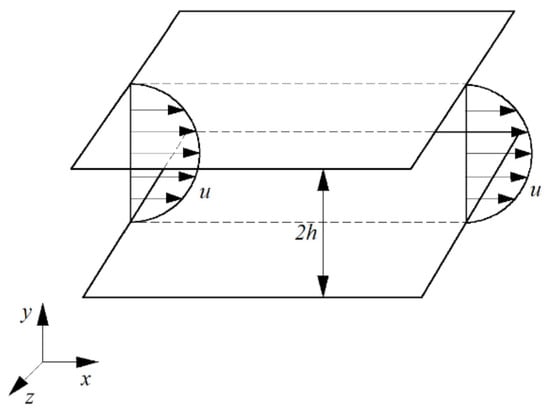
Figure 1.
Plane Poiseuille flow between two parallel plates with boundary conditions and initial conditions.
With the flow development from the interaction of the base flow with the disturbance, the velocity profile can be modified, depending on the Reynolds number and the disturbance, as in simulations and experiments [,,,]. For the incoming laminar velocity profile (Figure 2a) at a sufficiently high Reynolds number, after the velocity profile is distorted, inflection point appears first (point A in Figure 2b), and then a section with positive second derivatives appears on the downstream velocity profile (section A–B in Figure 2c). The velocity profile with positive second derivatives may play an important role in the formation of singularity. Three features of the streamwise velocity profile are shown in Figure 2.
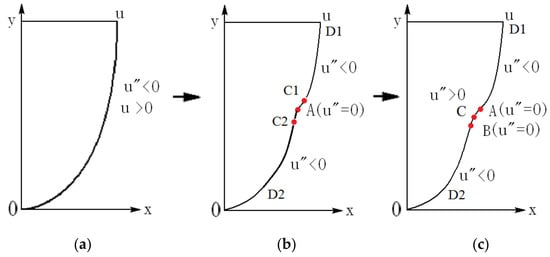
Figure 2.
(a) Velocity profile of laminar flow; (b) an inflection point appears on the velocity profile indicated by A, and the second derivative of velocity , except point A; (c) the second inflection point B is produced after the first inflection point A, and a section of appears on the velocity profile (A–B section). Here, stands for the second derivative of the velocity to the direction normal to the wall, . In the figure, A: inflection point; B: second inflection point; D1: upper part; D2: lower part; C1: point between A and D1 in (b); C2: point between A and D2 in (b); C: point between A and B in (c).
Numerical simulations and experimental data show that when the laminar flow is disturbed, the velocity profile will change, and some positions of the velocity profile will be distorted. The results of theoretical analysis on plane Poiseuille flow by Dou show that the basic flow has the maximum ability to amplify the disturbance at y/h = 0.58, and the velocity distortion is the largest there [,]. Numerical calculations and experiments have shownthat the place where the maximum disturbance appears and the velocity profile change first occurs is at y/h = 0.58 [], where the velocity profile shows an inflection point. These results confirmed the analytical results by Dou and co-authors [,,,,,]. However, there is little change in the velocity profile at the center line and near the two walls in the early stage of disturbance amplification in plane Poiseuille flow.
Dou proved with the energy gradient theory that when there is an inflection point on the velocity profile, discontinuity (negative spike) of streamwise velocity occurs in the temporal evolution under disturbance [], which is in agreement with simulations and experiments. A model for the velocity distribution at the discontinuity was proposed as shown in Figure 3, which occurs immediately after the inflection point is formed on the velocity profile.
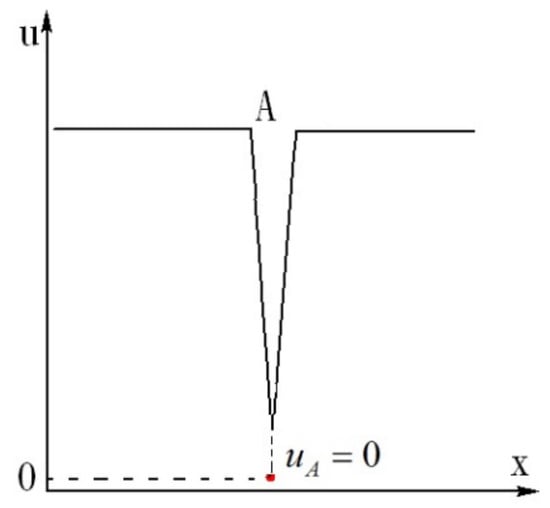
Figure 3.
Streamwise velocity distribution under finite disturbance for high Reynolds number flow (transitional flow), showing the singular point (velocity discontinuity) in the vicinity of the inflection point A [].
Leray did pioneering work on the weak solution of the Navier-Stokes equations []. Foias et al. summarized that []: “Leray speculated that turbulence is due to the formation of point or ‘line vortices’ on which some component of the velocity becomes infinite.” “Even today, despite much effort, Leray’s conjecture concerning the appearance of singularities in 3-dimensional turbulent flows has been neither proved nor disproved”.
As far as we know, the singularity in turbulence conjectured by Leray is never found in experiments and simulations (the first type of singularity mentioned in the Introduction). In contrast, the second type of singularity (zero streamwise velocity off the solid wall) is confirmed by experiments and simulation results [,,,], as described in []. The aim of present study is an alternative approach to achieve the same conclusion as that in our previous work []: that there exist no smooth and physically reasonable solutions of the Navier-Stokes equation for transitional flow and turbulence in the global domain due to singularity (for pressure driven flows).
5. Significance of the Singularity in Turbulence
In the transition of laminar flow to turbulence, the singularity at the inflection point (or its neighborhood) results in a “burst”, as observed by previous experiments []. The burst is the origin of turbulence generation and production of turbulent stresses. In other words, the flow relieves this singularity by a “burst” at the inflection point, and the singularity is converted into turbulent fluctuations at the said position.
In present study, singularity on the velocity profile in finite time for the incompressible Navier-Stokes equations is both mathematical and physical. In mathematics, this singularity of the Navier-Stokes equation occurs at (or near) the inflection point, which makes the equation not differentiable at this position. In physics, this singularity leads to a “burst” as well as fluctuations of streamwise velocity and other velocity components, i.e., turbulence if the Reynolds number is sufficiently high. The mechanical energy of the mainstream flow is transmitted to turbulent fluctuations via this singularity. The singularity is also the reason why turbulence cannot be repeated exactly.
In physical fluid flows in the laboratory, the flow is three-dimensional under finite disturbance, rather than two-dimensional. Further, two-dimensional disturbance isn’t able to induce this type of singularity, since the fluid element is subjected to both shear and extension at the singularity. In other words, there is also stretch of spanwise vorticity at the singular point.
As discussed before, at the singular point (inflection point), the streamwise velocity is theoretically zero. In order to conserve the total mechanical energy, the pressure at this point reaches its maximum. In the near upstream of the singular point, the disturbance is already three-dimensional (even though the amplitude is small). At the singular point, the disturbance is largest, with that singularity leading to “explosive burst” where the amplitudes of fluctuations of both velocity and pressure are largest. The pressure maximum at the singular point produces a pressure wave that spreads as its elliptical property.
Finally, it is pointed out that since the studied singularity of the Navier-Stokes equation is caused by a vanishing viscous term in the Navier-Stokes equation at the inflection point of the velocity profile in the flow domain (Laplace operator is zero), such singularity is never produced in inviscid flows governed by the Euler equation. This implies that turbulence, the properties of which are dissipative, with temporal bursting, with increasing resistance, and with self-sustained fluctuations, could not be generated in inviscid flows.
6. Conclusions
Solutions of the Navier-Stokes equation with the Poisson equation form are studied by analyzing the variation of the velocity profile versus the Re number and the disturbance. For the steady laminar flow between two parallel plates, the Poisson equation dominates the flow with the source term of no vanishing. For the laminar flow at a sufficiently high Reynolds number and under certain finite disturbance, the velocity profile is distorted downstream and an inflection point appears (or kink appearance). With the evolution of the velocity profile under finite disturbance, in the vicinity of the inflection point, it is found that there is always a position with (i.e., = 0). This point is singular in the global domain for the Poisson equation (Navier-Stokes equation). At this kind of singular point, the flow variables are not differentiable. Therefore, there exist no smooth and physically reasonable solutions of the Navier-Stokes equation in transitional and turbulent flows.
It should be pointed out that the reasoning presented in this study is only for pressure-driven flows. For shear driven flow, the same conclusion on existence and smoothness of the solution of the Navier-Stokes equation can be obtained with the boundary conditions changed, but the work done by shear stress should be taken into account (this work will be published in separate paper). For shear-driven flows, the mechanisms of instability occurrence and turbulent transition have been studied, respectively, for plane Couette flow and Taylor-Couette flow in [,], where external work has been included.
The above conclusion confirmed the analysis results with the energy gradient theory in [], which show occurrences of streamwise velocity suddenly stop and velocity discontinuity due to zero mechanical energy drop along the streamline. It was shown that the discontinuity of streamwise velocity forms the singularity of the Navier-Stokes equation.
Therefore, both approaches using energy gradient theory and Poisson equation analysis are consistent and show that there is a singular point in the vicinity of the inflection point on the velocity profile where the streamwise velocity is theoretically zero. Neither existence nor smoothness of the solution of the Navier-Stokes equation is demonstrated for transitional and turbulent flows.
Funding
This research received no external funding.
Institutional Review Board Statement
Not applicable.
Informed Consent Statement
Not applicable.
Data Availability Statement
The data are contained within the article.
Conflicts of Interest
The authors declare no conflict of interest.
References
- Foias, C.; Manley, O.; Rosa, R.; Temam, R. Navier-Stokes Equations and Turbulence; Cambridge University Press: Cambridge, UK, 2004. [Google Scholar]
- Fefferman, C.L. Existence and Smoothness of the Navier-Stokes Equation; Clay Mathematics Institute: Peterborough, NH, USA, 2000; pp. 1–6. Available online: http://www.claymath.org/sites/default/files/navierstokes.pdf (accessed on 23 February 2022).
- Leray, J. Sur le mouvement d’un liquide visquex emplissent l’espace. Acta Math. J. 1934, 63, 193–248. [Google Scholar] [CrossRef]
- Dou, H.-S. Energy gradient theory of hydrodynamic instability. In Proceedings of the Third International Conference on Nonlinear Science, Singapore, 30 June–2 July 2004; Available online: https://www.researchgate.net/publication/2147222 (accessed on 23 February 2022).
- Dou, H.-S. Mechanism of flow instability and transition to turbulence. Inter.J. Non-Linear Mech. 2006, 41, 512–517. Available online: https://www.researchgate.net/publication/245215903 (accessed on 23 February 2022). [CrossRef]
- Dou, H.-S. Physics of flow instability and turbulent transition in shear flows. Inter. J. Phys. Sci. 2011, 6, 1411–1425. Available online: https://www.researchgate.net/publication/2176288 (accessed on 23 February 2022).
- Dou, H.-S.; Khoo, B.C. Investigation of turbulent transition in plane Couette flows using energy gradient method. Advances in Appl.Math. and Mech. 2011, 3, 165–180. Available online: https://www.researchgate.net/publication/2147221 (accessed on 23 February 2022). [CrossRef] [Green Version]
- Dou, H.-S.; Khoo, B.C.; Yeo, K.S. Instability of Taylor-Couette Flow between Concentric Rotating Cylinders. Inter. J. Thermal.Sci. 2008, 47, 1422–1435. Available online: https://www.researchgate.net/publication/222709642 (accessed on 23 February 2022). [CrossRef] [Green Version]
- Dou, H.-S. Singularity of Navier-Stokes equations leading to turbulence, Advances in Applied Mathematics and Mechanics. arXiv Prepr. 2021, 13, 527–553. Available online: https://www.researchgate.net/publication/325464212 (accessed on 23 February 2022).
- Beale, J.T.; Kato, T.; Majda, A.J. Remarks on the breakdown of smooth solutions for the 3D Euler equations. Commun. Math. Phys. 1984, 94, 61–66. [Google Scholar] [CrossRef]
- Yao, J.; Hussain, F. On singularity formation via viscous vortex reconnection. J. Fluid Mech. 2020, 888, R2. [Google Scholar] [CrossRef]
- Moffatt, H.K.; Kimura, Y. Towards a finite-time singularity of the Navier-Stokes equations. Part 2. Vortex reconnection and singularity evasion. J. Fluid Mech. 2019, 870, R1. [Google Scholar] [CrossRef] [Green Version]
- Moffatt, H.K. Singularities in fluid mechanics. Phys. Rev. Fluids 2019, 4, 110502. [Google Scholar] [CrossRef] [Green Version]
- Schlichting, H. Boundary Layer Theory, 7th Ed. ed; Springer: Berlin, Germany, 1979. [Google Scholar]
- Nishioka, M.; Iida, S.; Ichikawa, Y. An experimental investigation of the stability of plane Poiseuille flow. J. Fluid Mech. 1975, 72, 731–751. [Google Scholar] [CrossRef]
- Biringen, S. Final stages of transition to turbulence in plane channel flow. J. Fluid Mech. 1984, 148, 413–442. [Google Scholar] [CrossRef]
- Sandham, N.D.; Kleiser, L. The late stages of transition to turbulence in channel flow. J. Fluid Mech. 1992, 245, 319–348. [Google Scholar] [CrossRef]
- Luo, J.; Wang, X.; Zhou, H. Inherent mechanism of breakdown in laminar-turbulent transition of plane channel flows, Science in China Ser. G Physics. Mech. Astron. 2005, 48, 228–236. [Google Scholar] [CrossRef]
- Luchikt, T.S.; Tiederman, W.G. Timescale and structure of ejections and bursts in turbulent channel flows. J. Fluid Mech. 1987, 174, 524–552. [Google Scholar]
- Alfredsson, P.H.; Johansson, A.V. On the detection of turbulence-generating events. J. Fluid Mech. 1984, 139, 325–345. [Google Scholar] [CrossRef]
- Schlatter, P.; Stolz, S.; Kleiser, L. Large-eddy simulation of spatial transition in plane channel flow. J. Turbul. 2006, 7, N33. [Google Scholar] [CrossRef]
- Nishioka, M.; Asai, M.; Iida, S. Wall phenomena in the final stage of transition to turbulence. In Transition and Turbulence; Meyer, R.E., Ed.; Academic Press: New York, NY, USA, 1981; pp. 113–126. [Google Scholar]
- Kim, J.; Moin, P.; Moser, R.D. Turbulence statistics in fully developed channel flow at low Reynolds number. J. Fluid Mech. 1987, 177, 133–166. [Google Scholar] [CrossRef] [Green Version]
- Johansson, A.V.; Her, J.-Y.; Haritonidis, J. On the generation of high-amplitude wall-pressure peaks in turbulent boundary layers and spots. J. Fluid Mech. 1987, 175, 119–142. [Google Scholar] [CrossRef]
- Bernard, P.S.; Thomas, J.M.; Handler, R.A. Vortex dynamics and the production of Reynolds stress. J. Fluid Mech. 1993, 253, 385–419. [Google Scholar] [CrossRef] [Green Version]
- Ghaemi, S.; Scarano, F. Turbulent structure of high-amplitude pressure peaks within the turbulent boundary layer. J. Fluid Mech. 2013, 735, 381–426. [Google Scholar] [CrossRef] [Green Version]
- Swearingen, J.D.; Blackwelder, R.F.; Spalart, P.R. Inflectional instabilities in the wall region of bounded turbulent shear flows. In Proceedings of the Summer Program; Center for Turbulence Research, Stanford Univercity: Stanford, CA, USA, 1987; pp. 291–295. [Google Scholar]
- Fletcher, C.A.J. Computational Techniques for Fluid Dynamics; Springer: Berlin, Germany, 1991; Volume 1. [Google Scholar]
Publisher’s Note: MDPI stays neutral with regard to jurisdictional claims in published maps and institutional affiliations. |
© 2022 by the author. Licensee MDPI, Basel, Switzerland. This article is an open access article distributed under the terms and conditions of the Creative Commons Attribution (CC BY) license (https://creativecommons.org/licenses/by/4.0/).
